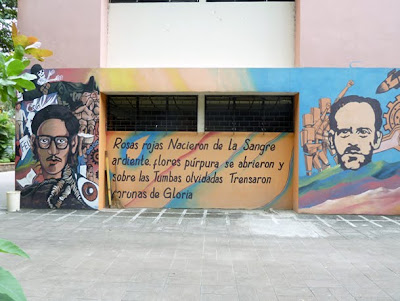Despite this, there was a lively atmosphere in the place. People pursued courses as well as they could. The political scene was intense, perhaps more intense than the academic scene on the campus.
Last week I gave a talk at the UES on the politics of photographic representation, in an auditorium where we had been numerous times in the past—it felt like a homecoming. But time pressure prevented me from taking more than a quick look around. Then this week, accompanied by a new acquaintance here who volunteered to be a sort of guide, I spent a few hours getting a good look around, and visiting the building where we used to work.
Back in 2003, the UES was the center for Central American youth games, and that was an incentive to do a lot of repairs, remodeling and construction, all of which is still going on.
The great surprise came when I visited our own building—Journalism—to find it there, but remodeled. Classrooms, studios, labs that were simply in ruins have been replaced with modern rooms, equipment and furniture.
The Central Library was another pleasant surprise. The construction of this building was finished when we were teaching there in ’94, but the building was an empty shell—no books, no journals, little furniture. Now it’s full of material (largely donated) and students.
But I had one additional bit of good luck—I visited in the wrap-up of the quadrennial two-week long electoral campaign, when various organizations and associations were working for their candidates for the top administrators of the UES. In the actual voting, students, professors and non-teaching professionals each get 1/3 of the votes.
One thing that has changed is that the many student organizations (three are legally recognized—the other thirty–plus are technically not legal) are not strongly connected to the major political parties, although as my friend pointed out, they accept money from them, in a fairly cynical way, But they do continue to fill the walls with murals and slogans, and to plaster them with posters and leaflets. More nostalgia for me….And some images for you...




















No comments:
Post a Comment